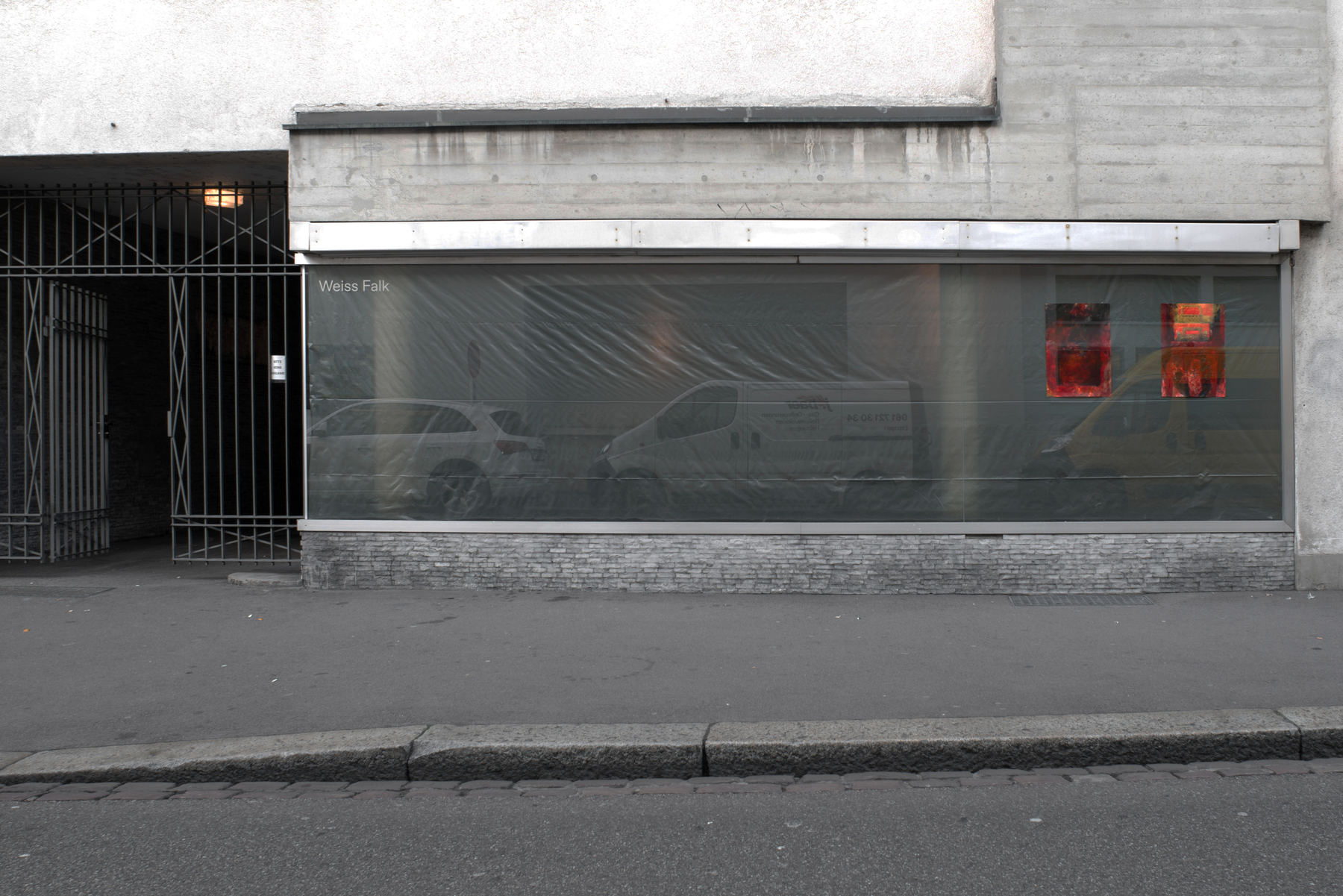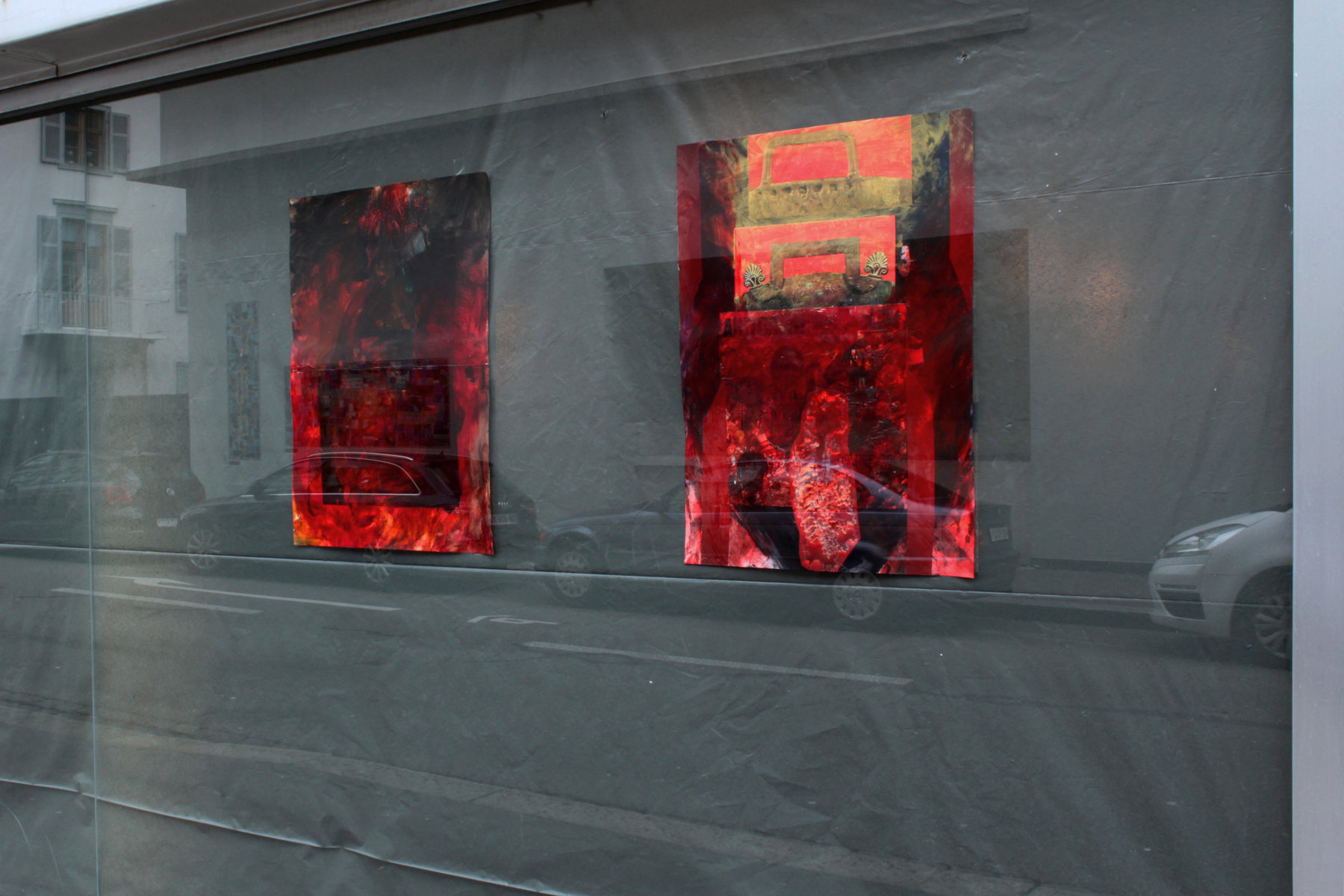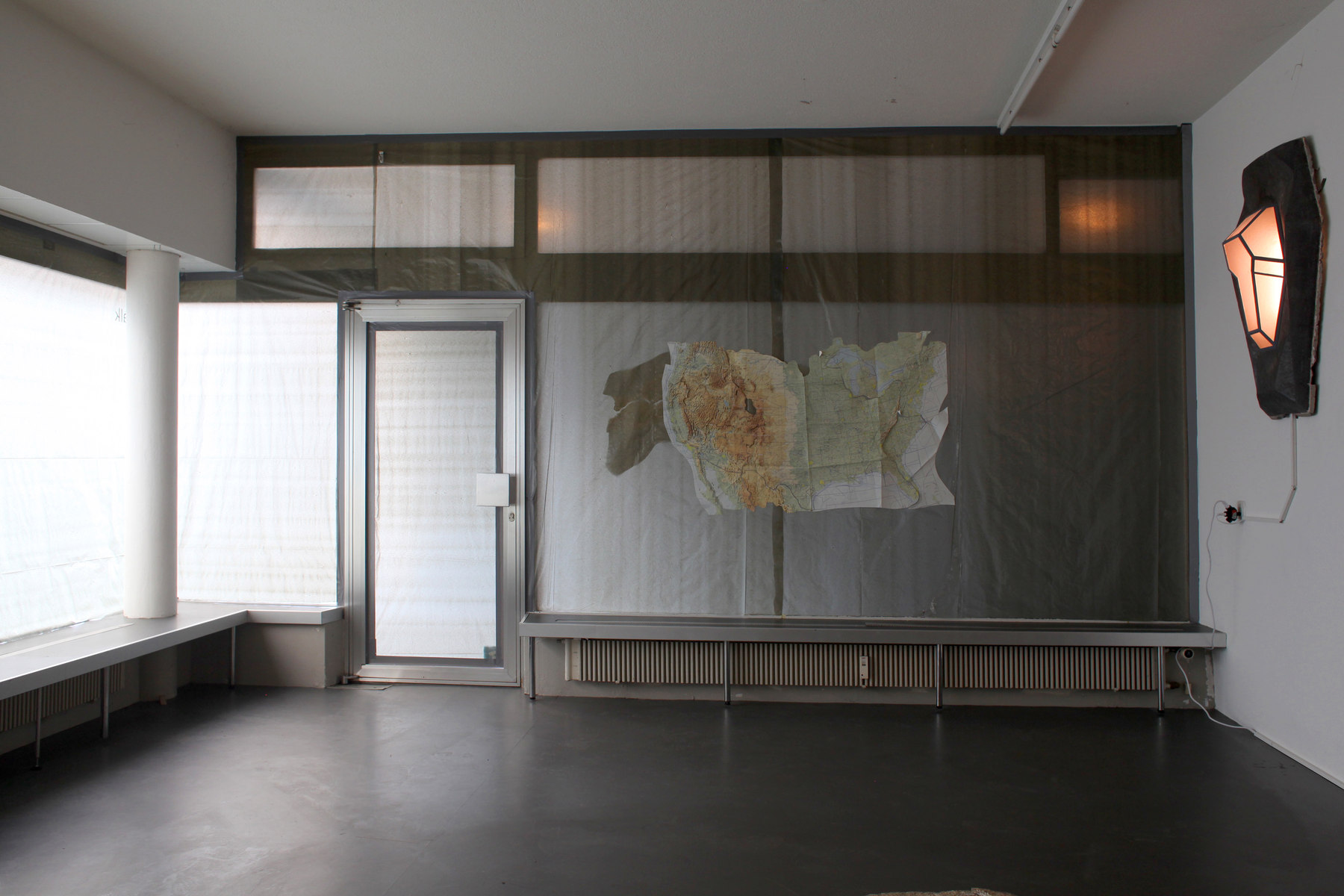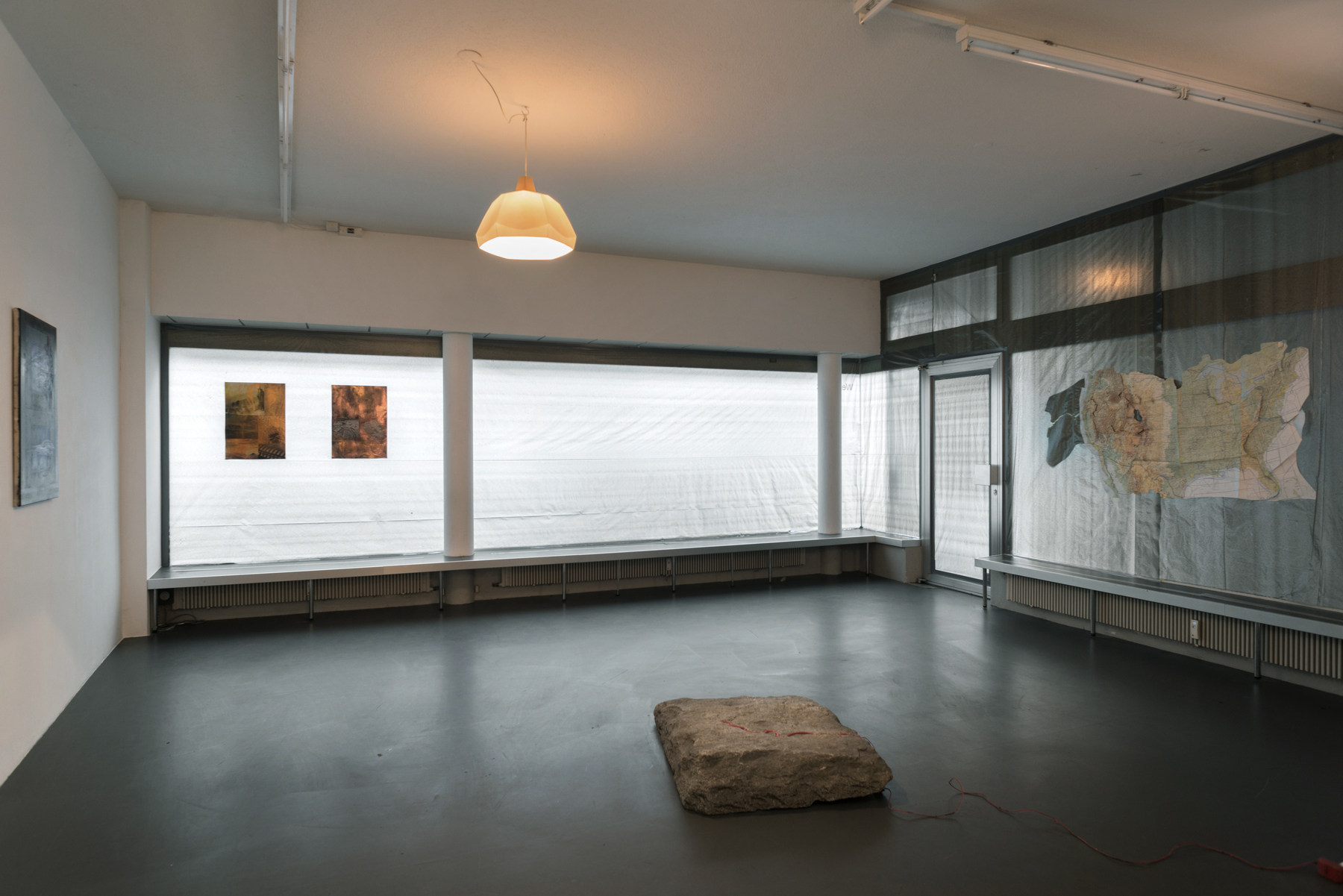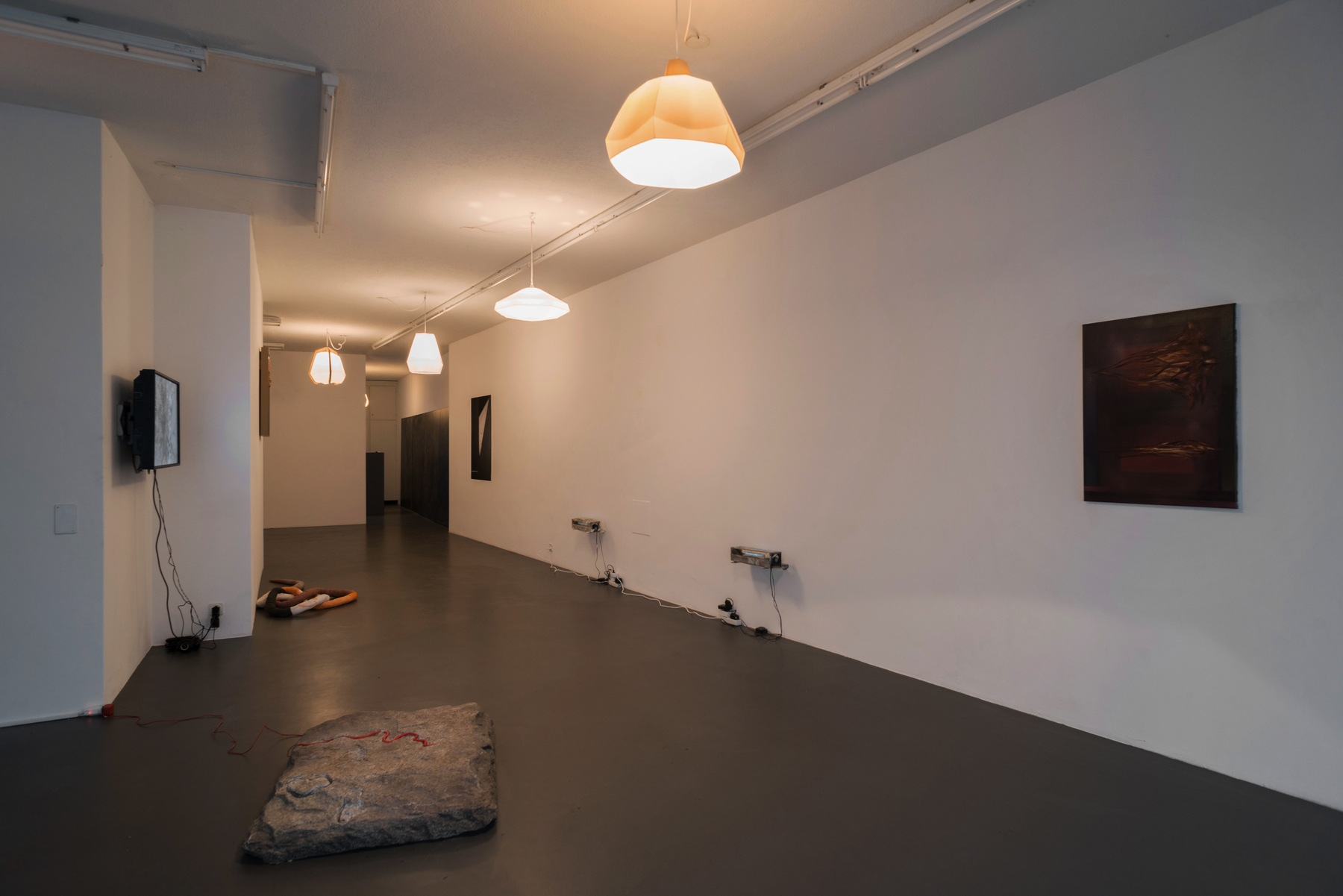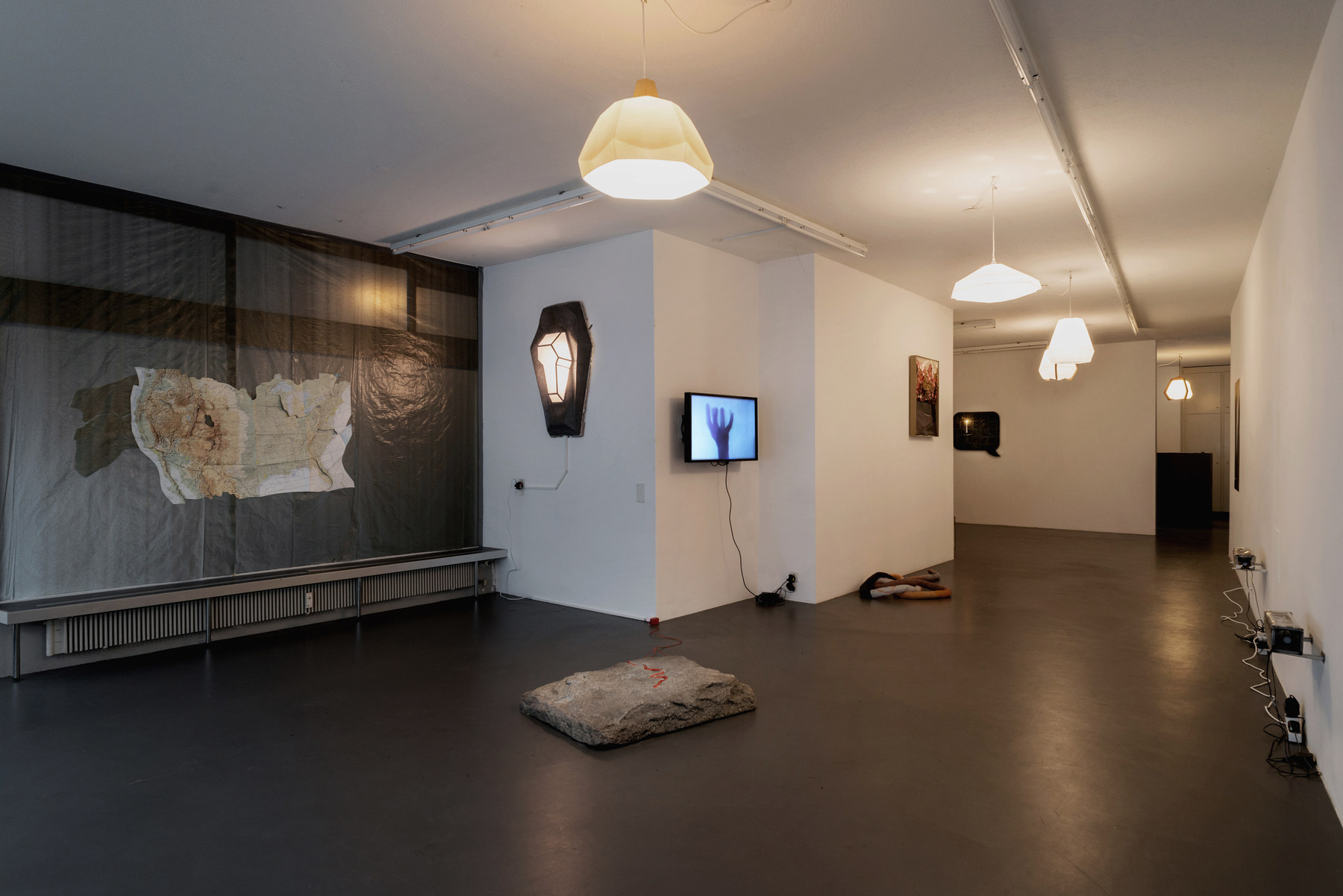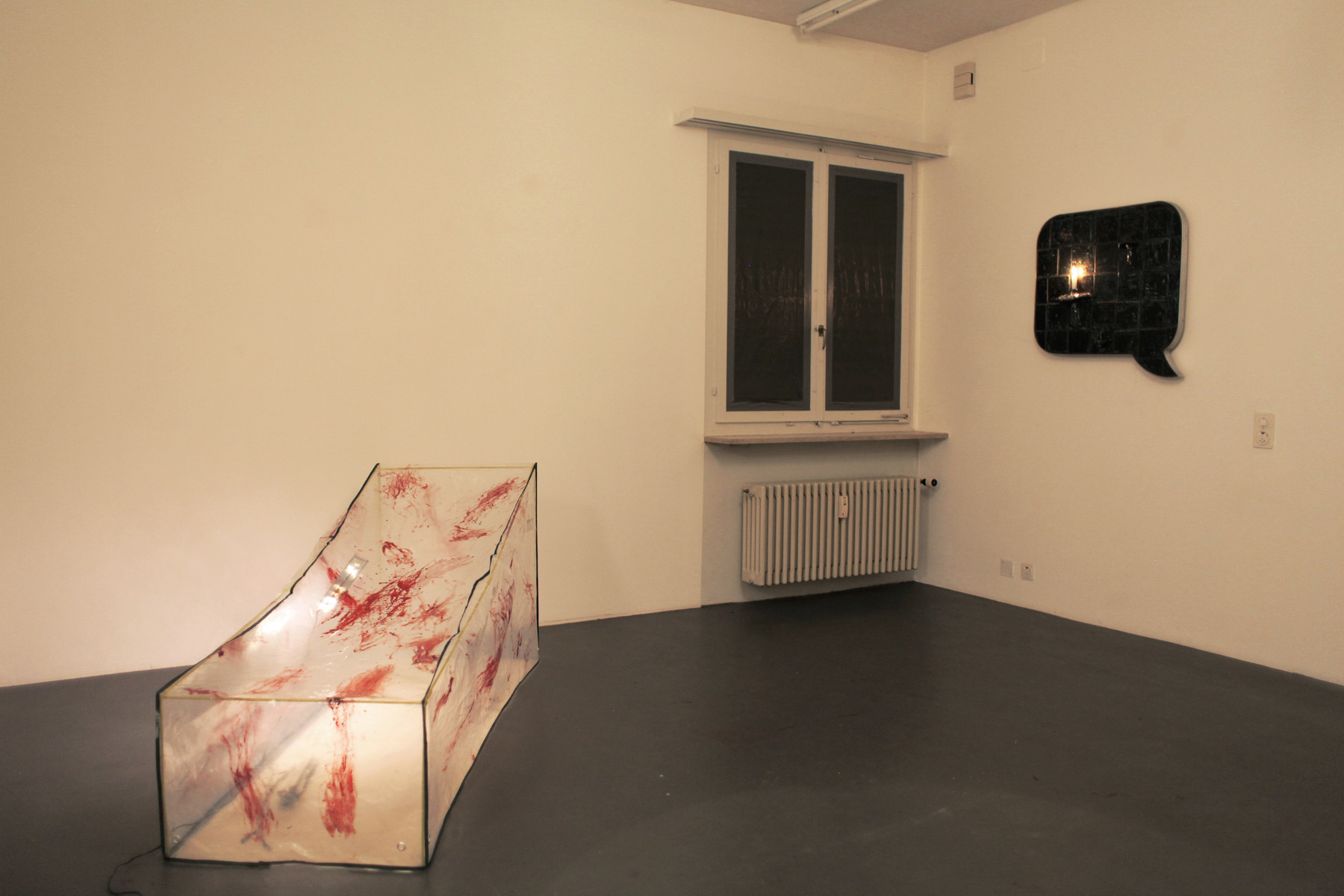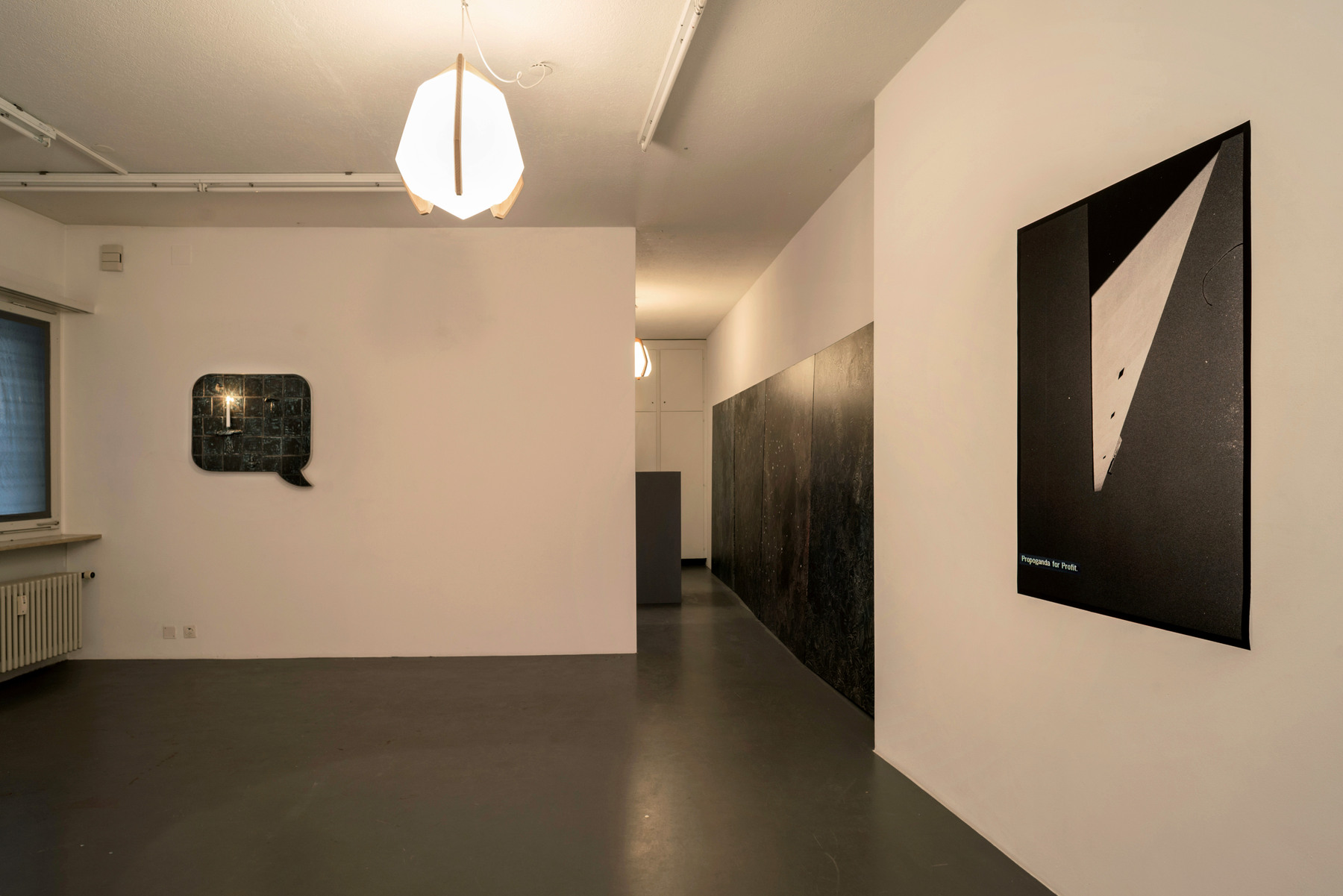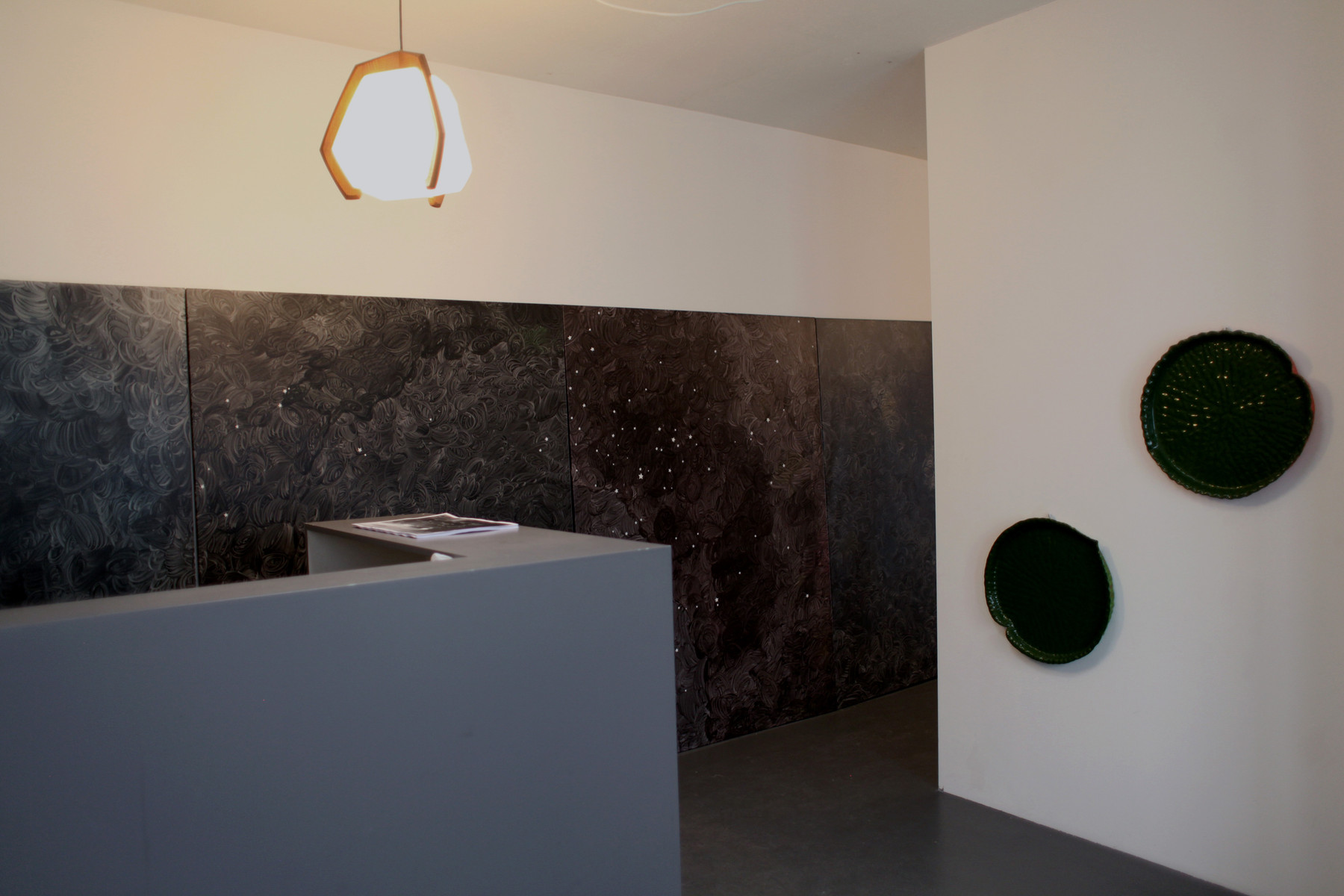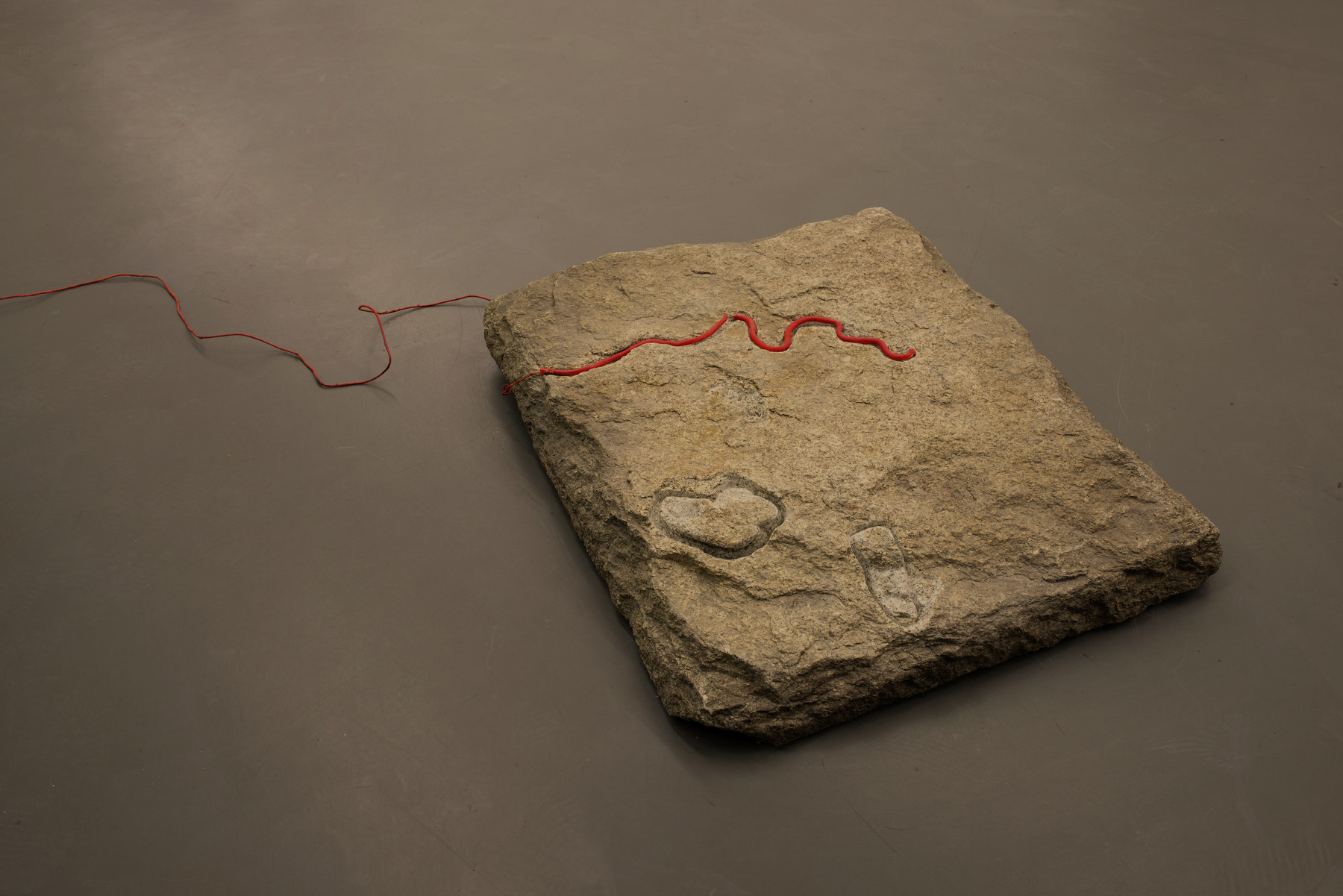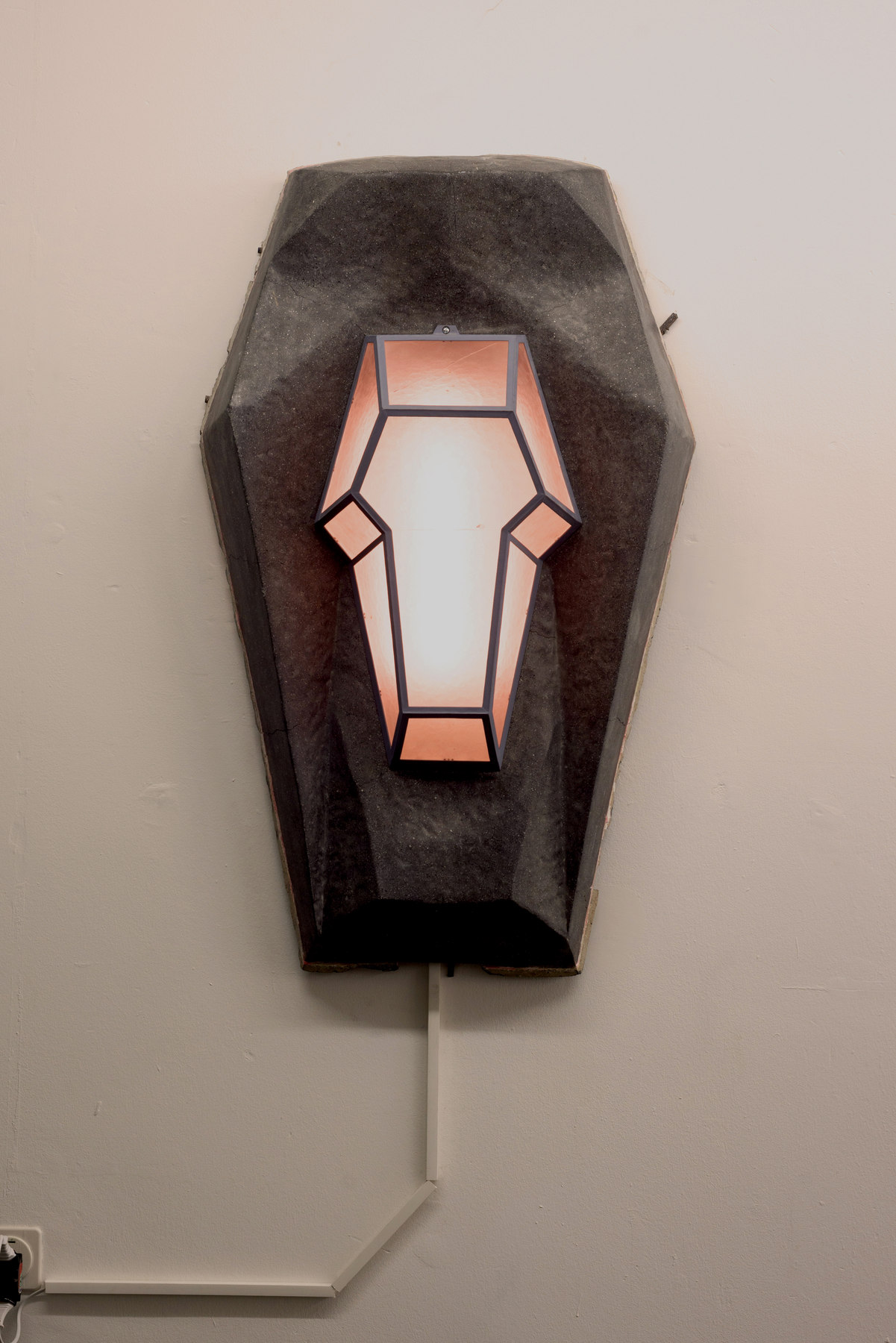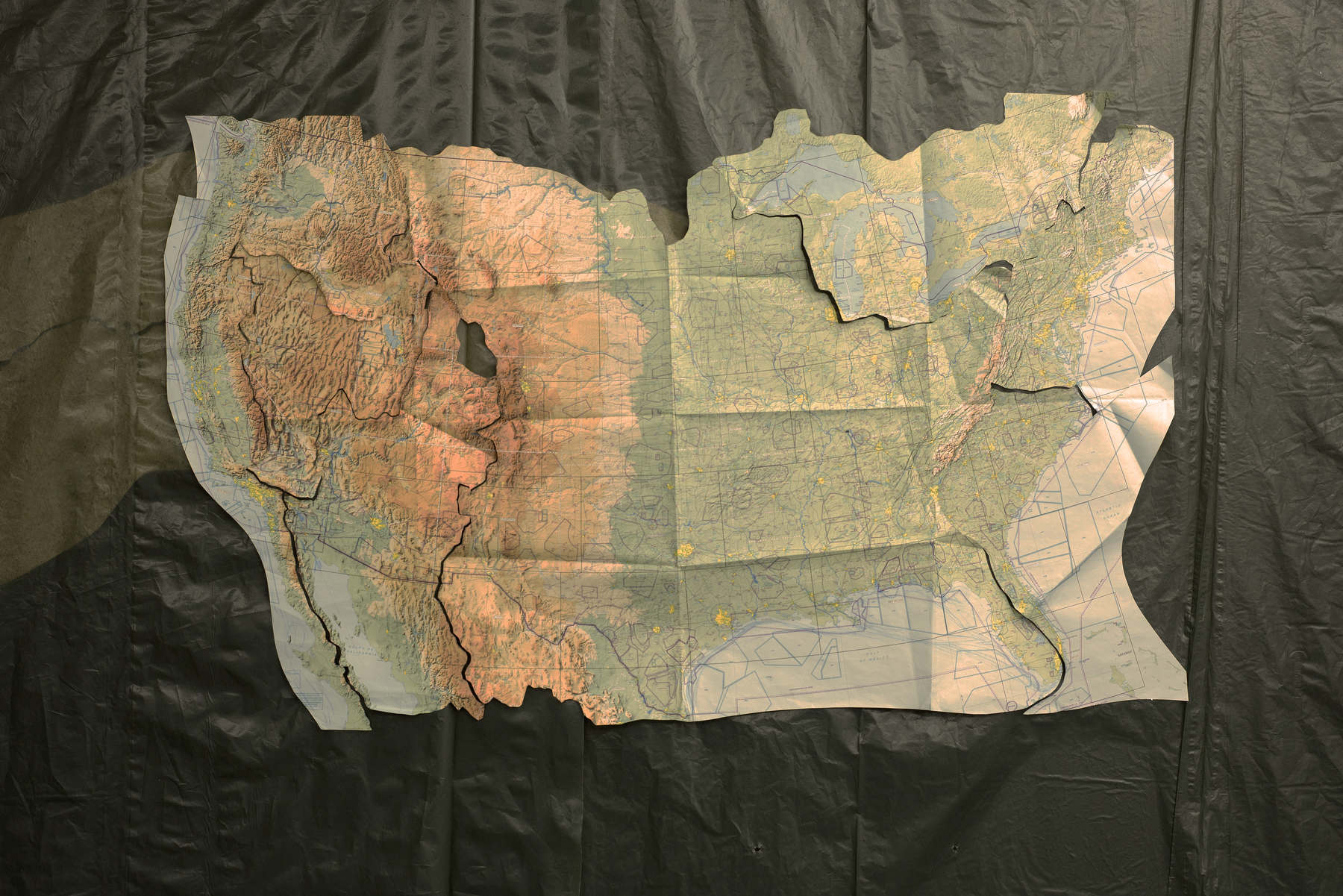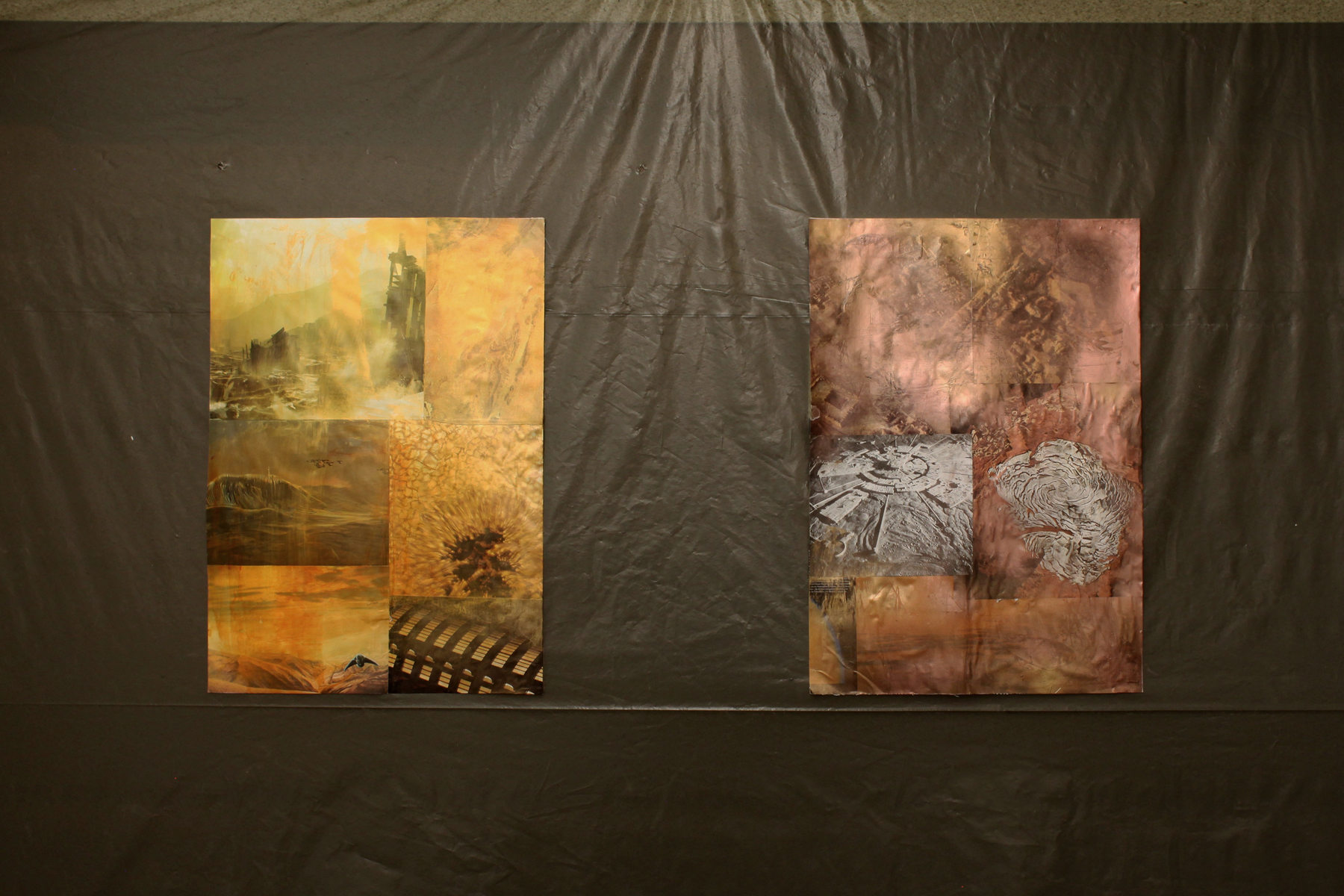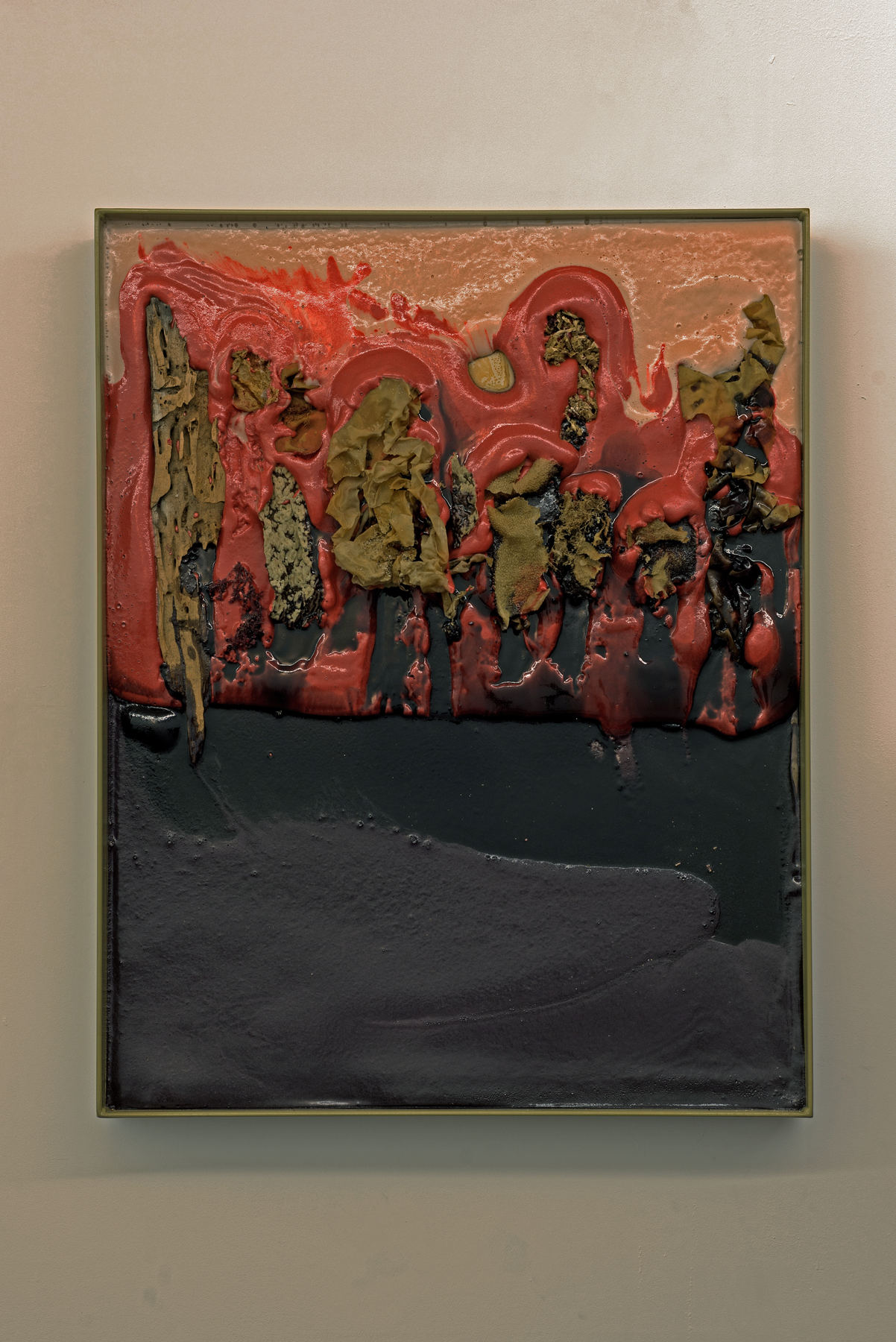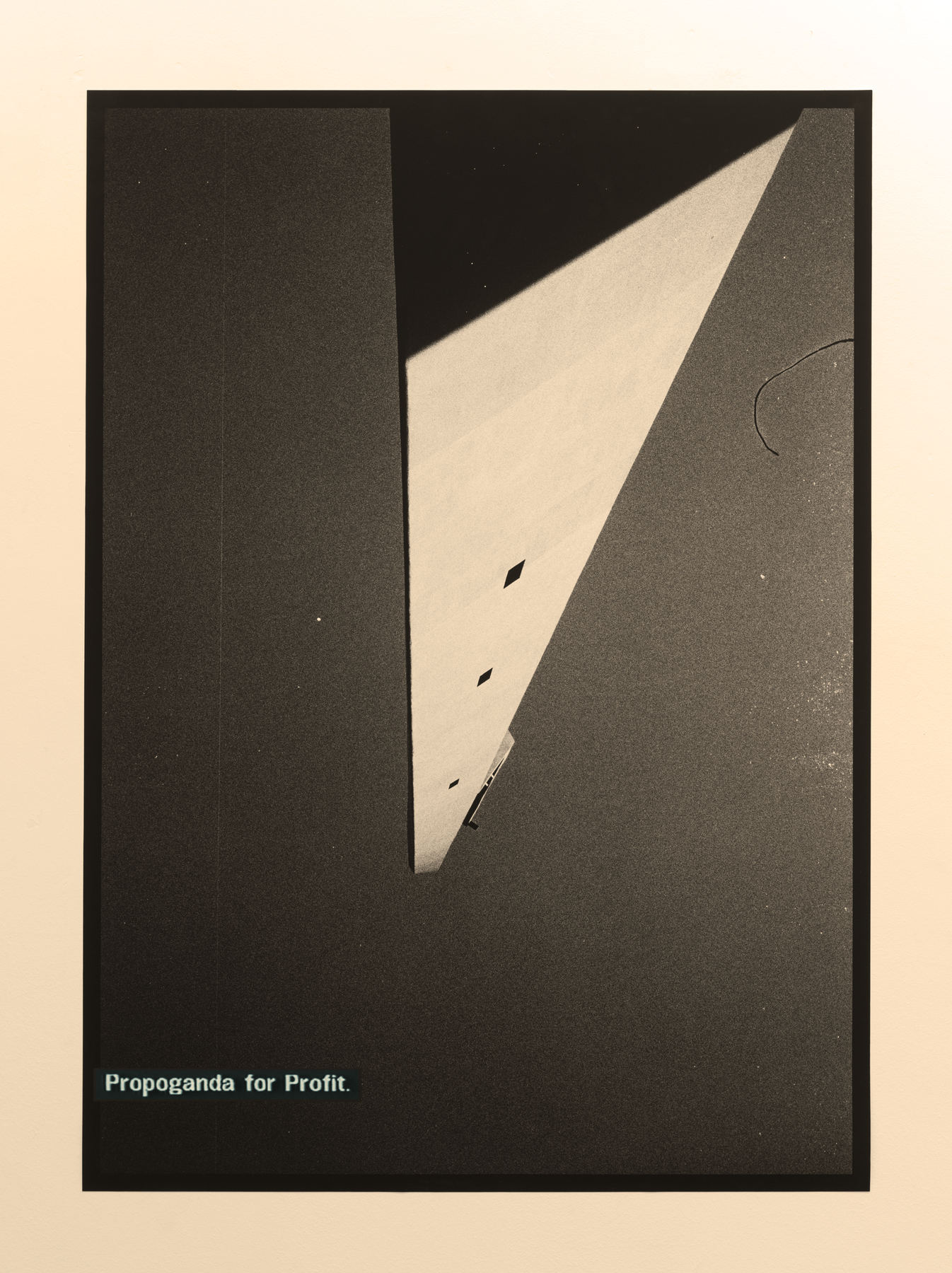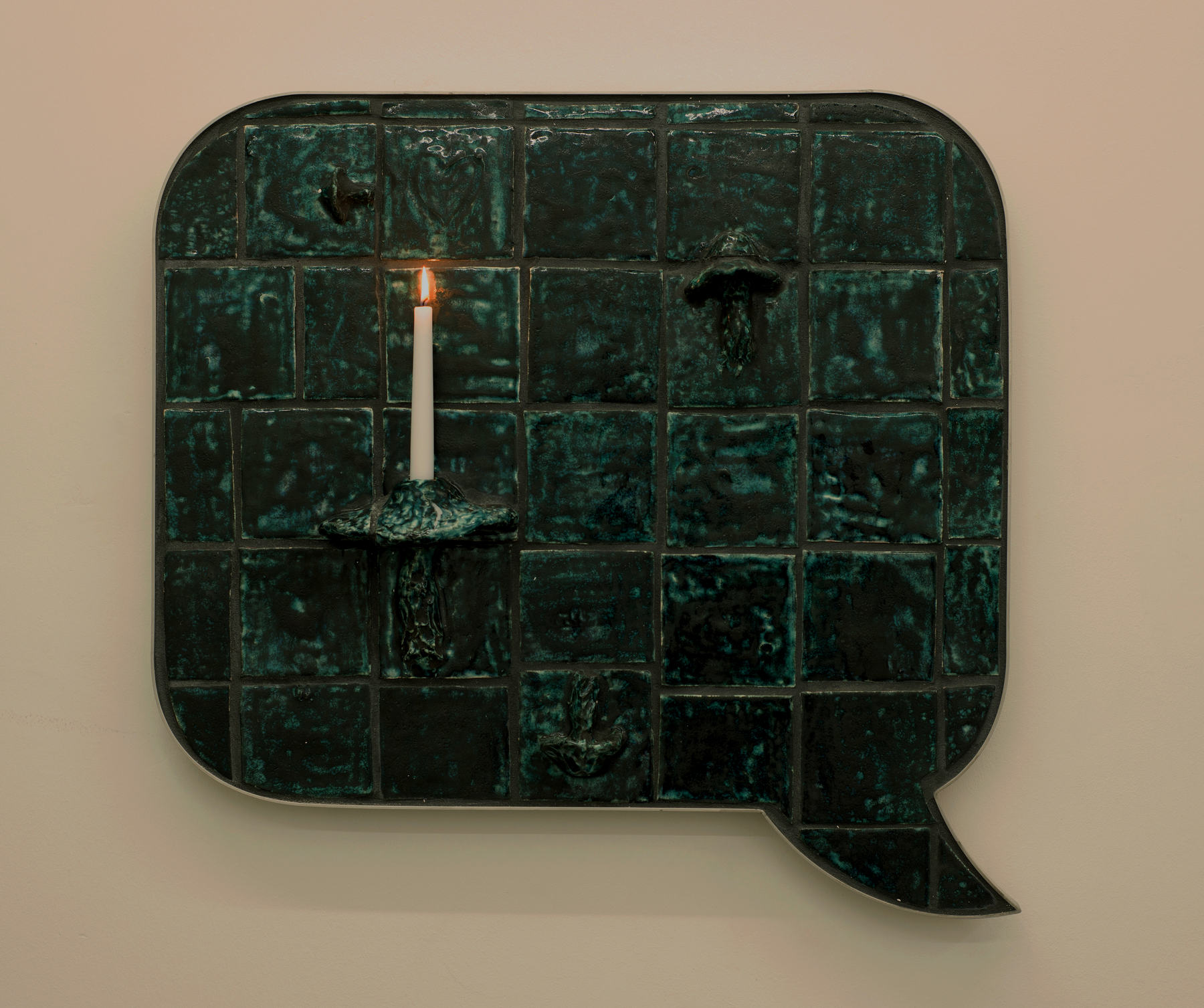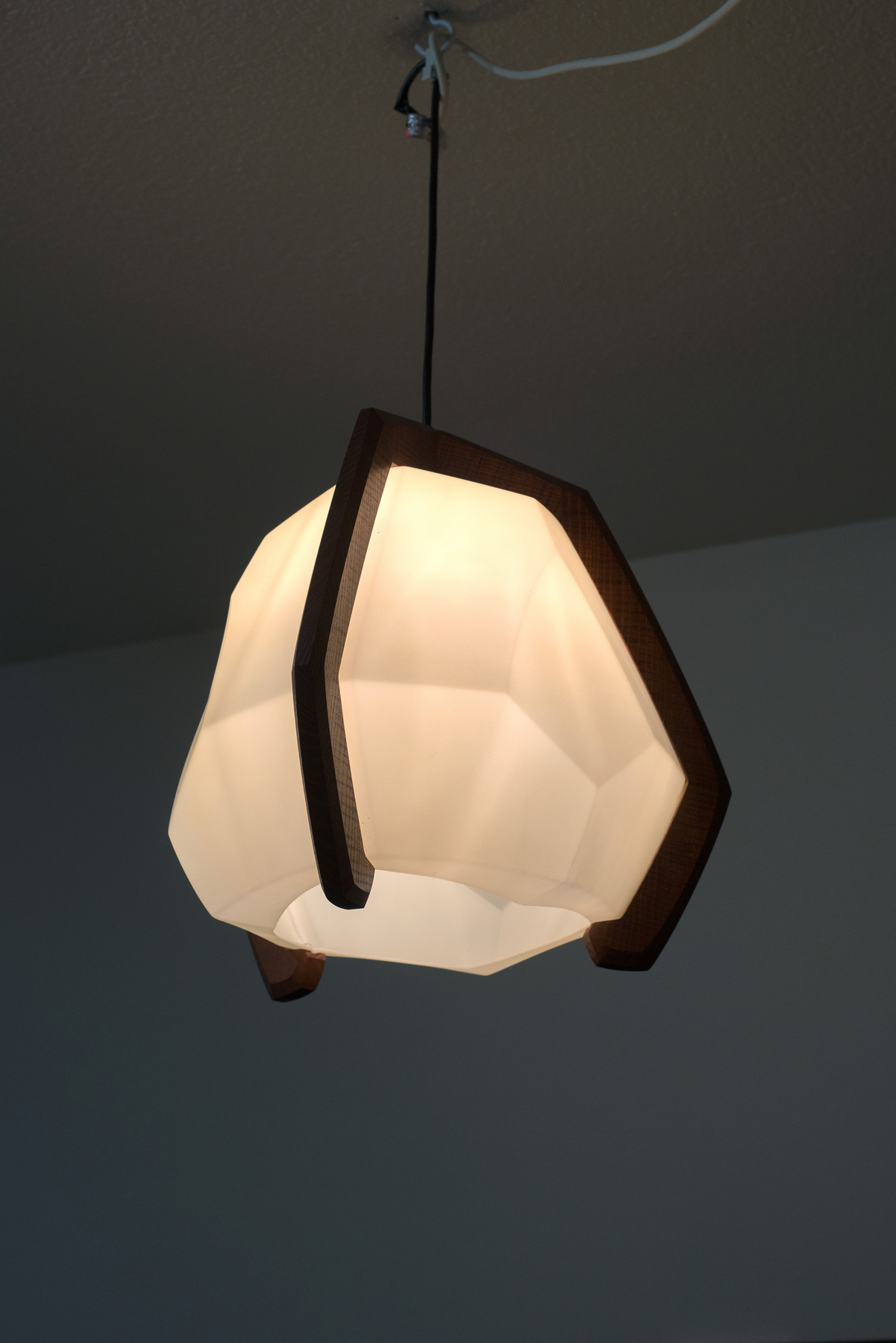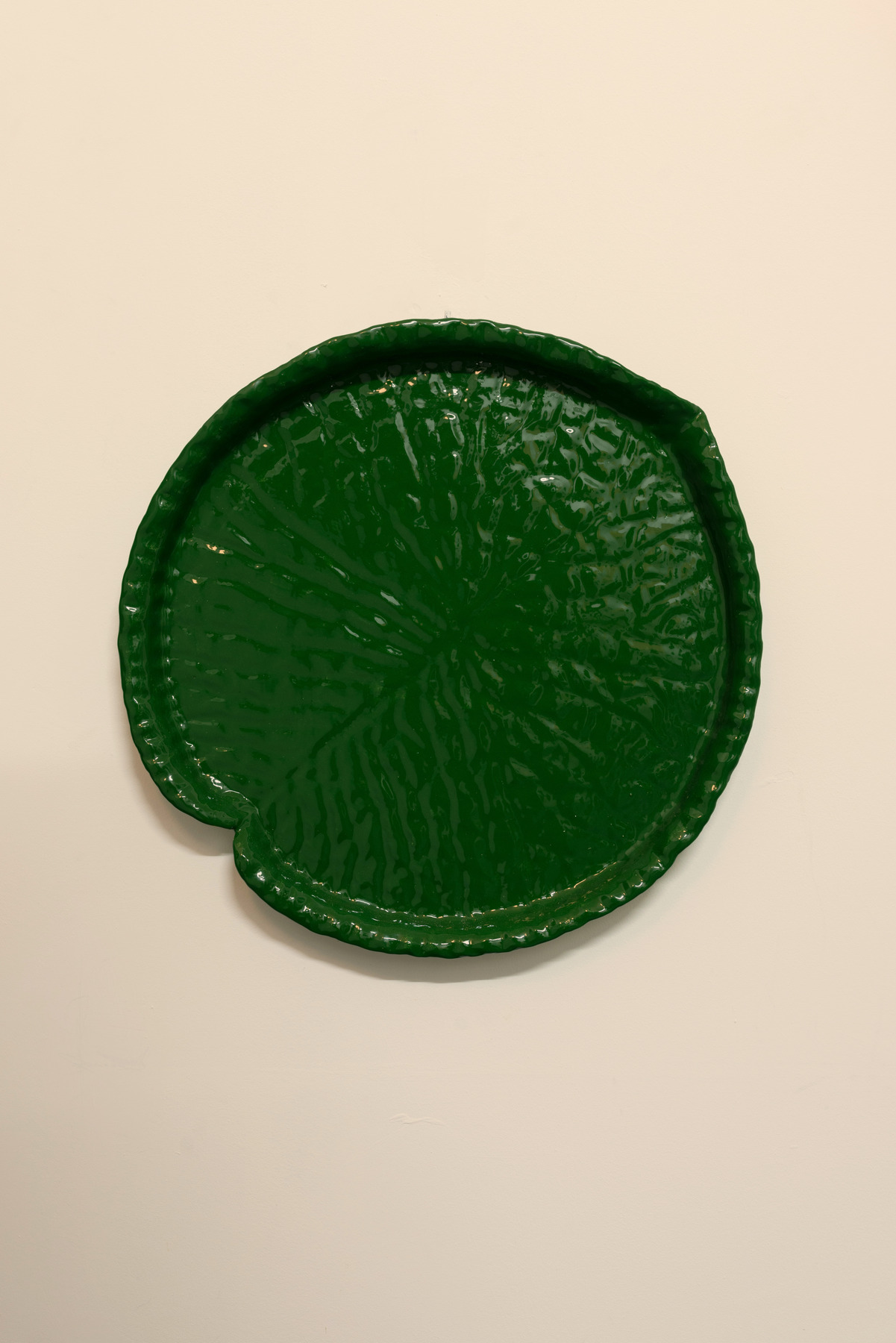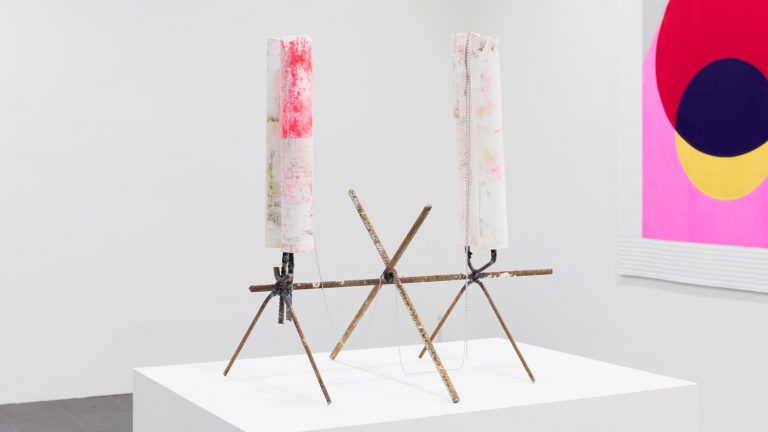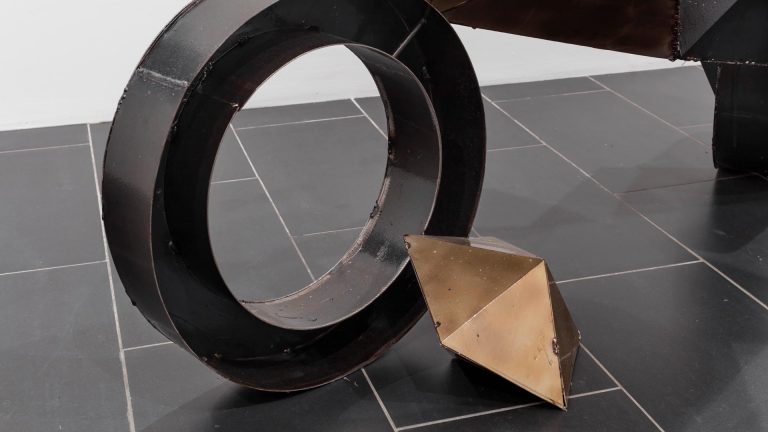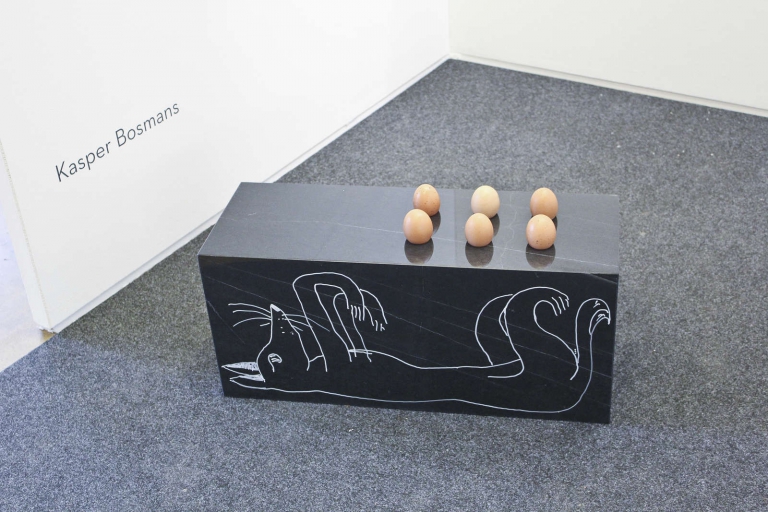Artists: Olga Balema, Liz Craft, Peter Fend, Mathis Gasser, Goetheanum, Nancy Halt, Lena Henke, Vera Karlsson, Chantal Kaufmann, Laura Langer, Bob van der Wal, Phillip Zach
Exhibition title: Aubades. Land Art for Aliens
Organised by: Julia Moritz and Bob van der Wal
Venue: Weiss Falk, Basel, Switzerland
Date: February 11 – March 11, 2017
Photography: Flavio Karrer & Bob van der Wal, all images copyright and courtesy of the artists and Weiss Falk, Basel
What happens if you replace a bird’s eye with the headlight of an aircraft? Let’s say, the predatory focus of a falcon’s eye with the white glaring light of an unidentified flying object of whale size. A change of perspective, to begin with. The dawn of dissolution and dismay: art works panic, who cares to save them anyways, they flee outdoors, egos explode. An aerial view from beyond our solar system, time tunneled perhaps. A first landing, looking for a jetty, a spiral one in the sight line. A first contact, of unparalleled negativity? A field of lightnings produced by far from fossil energies. Yet nothing really happens. You always knew it: They live among us now, between you and me, and sometimes within. Forget the lands, the desert too. Reroute the ocean signals. To Kleinbasel, no base too small for immediate alienation.
And that’s how we assumed the position of scientists from hell, or enlightened electricians, affixing the anthropocene onto anthroposophy, foraging the fields of symbolism / ritual / cult / occultism / astronomy / planetary problematics / meteorology / radiology / heating / growth / fertility / metamorphosis / biology / medicine / body culture / emotions / instincts / affect / drive / commerce / leisure / tourism / and time – giving birth to an exhibition, which includes a continuous persona, and this little book, likewise erratic and extensive, the almanac for abduction. What does It want?
ABDUCTION, by whatever forces, deprives of agency. No authority can be asserted here. You may have been kidnapped for a reason (your social status, your catastrophic karma), yet claiming any particular treatment won’t be of much help. If you can even communicate… What happens if you replace a person with a concept here? An art historical genre for that matter. We attempt to abduct Land Art (*1968, Dwan Gallery, New York), silence all estates, drag him to the outlandishest of territory, dissect its remains, breed new progeny, seek Stockholm syndrome, must love your hostage. And so: ab-ducere and e-ducare reveal as relatives. An inside job?
AUBADES, musical announcement of sunlight, morning love song. Serenade in the evening, separate in the dawn, rise and get out, why cling in the sun. What happens if you replace the early bird with – the lightswitch? The promethean impact of artificial light is what concerns us here. A trillion breakthroughs in daybreak per year. An industrialization-insomnia-complex. Yet do we really mourn hibernation? Flocks on the move, departures: artificial sleep to survive lightyears of space travel (or sometimes just a pill for a flight). Aubade anytime, shades implanted. Land art anywhere, space included.
And so we started in – Dornach, where the ANTHROPOSOPHICAL Society has its world’s center at the Goetheanum. Following Rudolf Steiner’s teachings of “the existence of an objective, intellectually comprehensible spiritual world that is accessible by direct experience through inner development”. While the outdoors of the colossal concrete-cast landmark (1923-28) herald impending bloom and dwarf any subjective doubt about it, its interiors however envelop you in an ever comforting light design, sourced from otherwordly window shapes and and a delicate range of sculpturesque lamp shades by Rudolph Dörfler (Artolux). While similar waves of automatization in the 1920s and 60s may result in parallel turns toward totalities such as the Land, the resulting forms of art bear striking similarities in their subtle embrace of technological means and imagination – a modernist contradiction that, typically, is none. A seedling to cyborgism.
“The sun with loving light makes bright for me each day, the soul with spirit power gives strength unto my limbs. In sunlight shining clear I revere, Oh God, the strength of humankind, which thou has planted in my soul, that I may with all my might, may love to work and learn. From thee stream light and strength to thee rise love and thanks.”
– Rudolf Steiner
OR
“Just as in the body, eye and ear develop as organs of perception, as senses for bodily processes, so does a man develop in himself soul and spiritual organs of perception through which the soul and spiritual worlds are opened to him. For those who do not have such higher senses, these worlds are dark and silent, just as the bodily world is dark and silent for a being without eyes and ears.” – Rudolf Steiner, Theosophy: An Introduction to the Spiritual Processes in Human Life and in the Cosmos
OR
“Our highest endeavor must be to develop free human beings who are able of themselves to impart purpose and direction to their lives. The need for imagination, a sense of truth, and a feeling of responsibility—these three forces are the very nerve of education.”
– Rudolf Steiner
We are thankful to the Baudepartement of GOETHEANUM and Rudolph Dörfler of ARTOLUX for generously lending examples of their lamp models to the enlightenment of the exhibition. They form a bright spine to it, standing tall also on the entrance wall. Because we modulated the daylight too: a murky plastic windows wrap, semi-translucent, semi-sure. Is this open?
Are you ready?
Is this even hung right? might be your second question, after encountering the two drawings Transmission (Red) and Handle (2016, Collage, Acrylic on Paper, 59 x 42 cm) of Mathis GASSER (*1984, Zürich) already on the sidewalk of Rebgasse, sending troubled greetings to the kindergarten’s window work across the street. And no, it’s not an afterimage but his two distinct drawings Landscapes (Yellow) and Terraforming (2016, Collage, Acrylic on Paper, 59 x 42 cm) that sit on the inside window, counter parting the doomsday dreamscapes. And yes, portrait or landscape are ultimately two sides of the same coin; the herbaceous vessel seeming to leave/land upside down in Gasser’s painting Formic Spaceship (Halley) (2015, Oil on Canvas, 80 x 58 cm) might also just face you. Acknowledging your entrance with a twisted goodbye.
An entry piece on a mission is offered by Peter FEND (*1950, Columbus), “named after Peter the Great (Russia), Frederick the Great (Prussian), born to parents ancestrally from Augsburg, Bavaria and southern Sweden, the paternal grandparents having left in 1912, with the last Bavarian king died, immer besetzt mit diesen Staemmen, (ein Bein in Nord-Amerika und US-Verfassung, ein Bein in Mitteleuropa, wie Schwarzesmeerbecken und Ostseebecken, in WWII Ostmark und Ostland, immer auf der Suche nach Loesungen und Erklaerungen für diese 20. Jahrhundert Kriege, immer auf der Suche nach Ersatz für die Erdoel/Erdgas-Industrie.” Legendary for his complex geopolitical/-strategic/-engineering proposals, often drawn, clipped, collaged, collaborated, printed, flagged, fedexed; here foregrounding the coming constellations with a topographical double bind: Unsere Lage (2016, ink on paper, dimensions variable) represents Cuban and Californian territorial assets in the racket for resources, and of course, grand systemic power, ever after.
But back to the sidewalk. Germany, die Hauptsadt – did you notice the ginormous slabs of granite used for pedestrian passage here? Olga BALEMA (*1984, Lviv) named it Untitled (shaky blood stone) and trimmed it with the miniature motor that makes your cellphone vibrate (2014, chiseled granite, motor, wiring, 80 x 97 cm). The builders of Berlin first imported the 600 million years old mineral from the Lausitz and Silesia regions in the 19th century. Its massive dimension dig into the city’s sandbed, a land hard to engineer. Carry a luggage over such walk way and vibrate like there’s no tomorrow.
And perhaps there actually isn’t. Given the footprints of morons onto these atmospheric straits and strata. Like lands ended with sight, like we ourselves might abduct their grandchildren under a different sun. Such the concern of New Zealand’s Bob VAN DER WAL (*1987, Auckland). Here shelved as Ozone Generator 1 and Ozone Generator 6 (each: 2016, mixed media, 10 x 45 x 10 cm), built from readily available parts and reused hotel metal appliances to cheaply clean up the gallery’s air with said gas.
More everyday domestic fragments swim in Vera KARLSSON’s (*1990, Gotland) Cola (2016, HD video, 05:55 min.). “Bodyparts and pets, you recognise the situation.” Gentrified potentialities – mouthpiece or speaker? – generic, abandoned, to be consumed again, spat out again, disjointed. They too take you, on a journey, continuously sliding from opposites to positrons to palm readings. While you apple-wrist-watch, absent-minded, her abstract-machine-music responding to the exhibition-tonight.
Like screens of smartphones, the surface of Phillip ZACH’s (*1984, Cottbus) Untitled(lava) connect the mind to another space-time, acting like gates opening up to wormholes (2016, painted steel, mdf, pigmented polyurethane, wood, stone, sea debris – all porous, inflated matter constituted by hollow spaces, mind you – 33 x 26 in 84 x 66 cm). This work comes with worm indeed, namely(almost) Untitled(lava) (2016, dyed fabric, cotton stuffing), crawling overseas from Zach’s recent show „Der Wurm als Wille und Vorstellung“ (2016, Los Angeles), which mobilized metaphors of worms and worm holes to show how movement of matter and mind, through mental and physical spaces, is determined by will. In his opus major The World as Will and Representation (1818) Schopenhauer describes the will to exist as a universal energy, inhibited by all life and matter – and the worm being the first living organisms able to give physical direction to that will through directional movement.
The will to power being a sort of consequence. Nietzschean drives aside, some times souls just seek sunlight, no matter what. The will to be born. Witness the delivery of Nancy HALT (*2017, Kleinbasel), neonate fictional persona for the purpose, in In Labour (2017, mixed media, 80 x 188 x 60). May birth be the first abduction? May death (of a famous-by-marginalization exceptional woman artist) relief a praxis (such as land’s art) from the shackles of estatus quo? May mimicry save you, Rose Sélavy.
And Richard Serra too. Meet your executrix: Chantal KAUFMANN (*1984, Luzern). Television Delivers People, titles major male monumental minimalist Serra the media critical short film, broadcast in 1973. Propaganda for Profit, excerpts Kaufmann the blue print and pastes it on her own photograph, printed together as same titled poster (2017, pigment print on paper, 117 x 83 cm) – the point still unsaid: the classic TV piece being a collaboration with the artist Carlota Fay Schoolman, of which you can find hardly anything www-ed…
We light a candle. On Liz CRAFT’s (*1970, Los Angeles) Mushroom Bubble (Black) (2016, ceramic, grout, aluminium and wood, 76 x 80 cm), speech bubble for the unsaid, or unsayable? If you can even communicate… And then again, mycelia certainly do. Rhizomatic organism/organization whose spores (psilocybe first), according to McKenna‘s panspermia theory, travelled space (being small and light enough to escape the gravity of a planet, and be swept by space currents) before sinking their filaments into these lands and bodies, interplanetary species no doubt, thus the purple hats allowing the spore to deflect UV light from the sun and other stars – see shroomery.org.
And so we make a final passage from the bubbling black soup of bliss to the boiling black broth of brain. Or mind, rather, says Laura LANGER (*1986, Buenos Aires) when remembering the painting of Night Stage (2016, oil on canvas, 200 x 600 cm): thinking about a picture of the mind, clarity, consciousness. A background still, it seems, and then again: “background is all there is around a self and inside and the stars as what we know or what we understand but i don‘t know.” And we agree.
And conclude with – life. With lilies. And yet with urbanism too, bracketing that nature/culture divide, age old problem. As Lena HENKE (*1982, Warburg) synthesizes in her two LilyPad after Roberto Burle Marx (2016, ceramics, 50 x 52 cm) alongside her recent interest in water, life’s main component, civilization’s arteries. Real in size and bright in green the pads (hung near rear door, you almost made it) evoke the Brazilian modernist architect’s landscape gardens (like: roof garden of the Ministry of Education in Rio de Janeiro, 1937), lingering between dominion and domestication. As we all do.
Or, in some final words by pioneering electronic artist and poet Aldo Tambellini:
There is the struggle of man to expand his senses in attempting to become organic with his scientific environment. His newly discovered nature. The rebellion is against man as an exploited economic commodity, man as a specialized entity. We have witnessed the exploitation of the black man and the apathy of the artist, the specialization of the picture maker, the writer, the music maker is challenged by programmed computers able to produce the same act of specialization. The computer age places a higher demand on the creative artist. The octopus spreads in many directions under one core. The process of art has disappeared. Electromedia is our era. We must get to the heart of the medium– to its tube – its filament – its energy. We must produce visions from the stuff which media are made of. It is from blackness that we begin to be re-sensitized. For blackness is like the womb where light was first felt, perceived, but, not yet seen.
Peter Fend, Unsere Lage, 2016, Ink on Paper, Dimensions variable
Olga Balema, Untitled (Shaky Blood Stone), 2014, Chiseled Granite, Motor, Epoxy, Component Glue, Acrylic Paint, 13 x 80 x 97 cm
Lamp from the Goetheanum
Peter Fend, Unsere Lage, 2016, Ink on Paper, Dimensions variable
Mathis Gasser, Landscapes (Yellow), 2016, Collage, Acrylic and Spray on Paper, 59 x 42 cm; Mathis Gasser, Terraforming, 2016, Collage, Acrylic on Paper, 59 x 42 cm
Mathis Gasser, Formic Spaceship (Halley), 2015, Oil on Canvas, 80 x 58 cm
Vera Karlsson, Cola, 2016, HD Video, 05:55 min
Bob van der Wal, Ozone Generator 1, Ozone Generator 6, 2016, Mixed Media, 10 x 45 x 10 cm
Lamp from the Goetheanum
Phillip Zach, Untitled (Lava), 2016, Painted Steel, Mdf, Pigmented Polyurethane, Wood, Stone, Sea Debris, 84 x 66 cm
Phillip Zach, Untitled (Worm), 2016, Dyed Fabric, Cotton Stuffing, Dimensions variable
Chantal Kaufmann, Propaganda for Profit, 2017, Pigment Print on Paper, 117 x 83 cm
Lamp from the Goetheanum
Nancy Halt, In Labour, 2017, Mixed Media, 80 x 188 x 60
Nancy Halt, In Labour, 2017, Mixed Media, 80 x 188 x 60
Liz Craft, Mushroom Bubble (Black), 2016, Ceramic, Grout, Aluminium, Wood and Candle, 76 x 80 cm
Liz Craft, Mushroom Bubble (Black), 2016, Ceramic, Grout, Aluminium, Wood and Candle, 76 x 80 cm
Lamp from the Goetheanum


